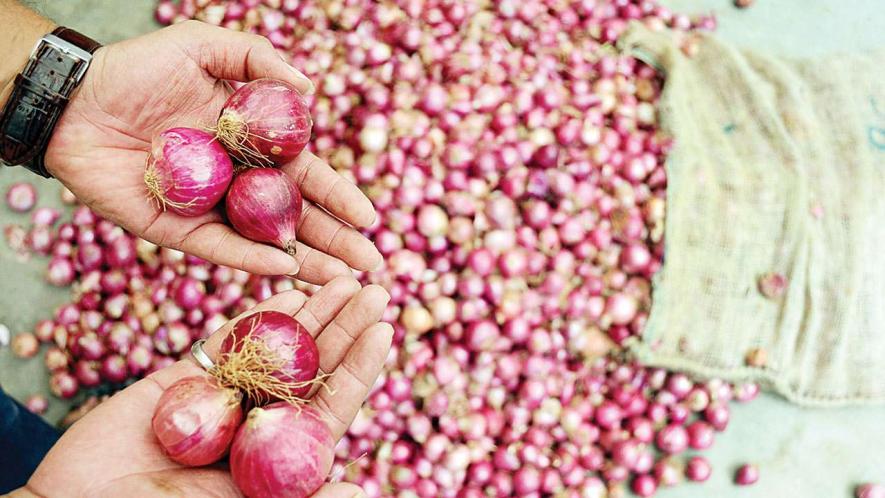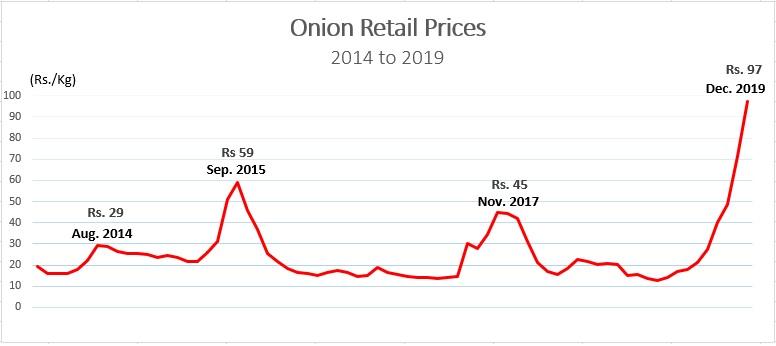Onion Prices Spiked by 253% in Five Months

Image Courtesy: DNA India
The grand old problem of onion price rise is back but this time it has been squeezing the ordinary people for more than three months. Between August and December this year, the average prices (across markets in the country) spiked by a whopping 253%, the highest increase in this decade. While the average retail price is nearly Rs 100 per kilo, onion prices have hit Rs 200 per kilo mark in some big cities in the first week of December, according to reports.
Before the Narendra Modi-led Bharatiya Janata Party government came to power in 2014, one of the major failures of the previous United Progressive Alliance (UPA) was its inability to control the prices of staple food, mainly onions. It was also one of the major reasons on which the then Opposition, NDA, had criticised the ruling regime. However, since then, the situation has only gotten worse which shows the track record of Modi government.
Meanwhile, farmer’s groups predict that the situation would lead to overproduction of onions in the next season as farmers have never seen such massive prices for onions. “Area under rabi onion will jump substantially as farmers have not seen such high onion prices ever,” said Jayadatta Holkar, director of Agricultural Produce Market Committee (APMC) at Lasalgaon to Economic Times.
Also read: Onion Prices Shoot up to Rs165/kg Across Cities
While analysts have been attributing this current onion crisis to the floods in Karnataka and Maharashtra this year—which are the largest producers of the vegetable—it doesn’t seem to be the sole reason for the crisis. According to the agriculture ministry estimates, onion production stood at 23.28 million tonnes in the agricultural year ending June 2019. This figure is very close to that of last year.
Competition Commission of India has twice conducted assessment of onion markets in India—in 2012 and 2015—to realise the core trigger of the recurring onion price problem in the country. In those two studies, one glaring point that emerged was that the collusion among traders in selected markets in Maharashtra and Karnataka may have resulted in high prices of onion. In addition, factors such as significant marketing costs, lack of market infrastructure, control of trade in the hands of few traders, restrictions on entry of new traders, frequent strikes by market functionaries, and can also lead to inflation of onion prices.
However, instead of fixing the problems, the government has relaxed the norms concerning onion imports to immediately import onions from other countries. This move has attracted severe criticism from farmers’ unions.
“We are not against imports but its timing is wrong. The onions that the government is importing now will reach India when local production will be high. Onion farmers have incurred heavy losses during the past two years and it will be fair to let them recover their losses,” Raju Shetti, former MP and founder of the Swabhimani Shetkari Sanghatana, a farmers’ union, was quoted by the Economic Times.
Reportedly, between 2010 to April 2014, there were five spikes in onion prices.

Source: Annual Price and Arrival Report, National Horticulture Board
After the BJP came to power at the Centre, the first hurdle it encountered was a massive spike in oni on prices. Between May and July 2014, the prices spiked by 62%. The following year, the prices spiked by 125% between June and September 2015, reaching above Rs 60 per kilo. In 2017, prices spiked twice, by about 106% between July and August, and by 60% between September and November.
In 2019, while the retail onion prices were recorded at Rs 27 per kilo in August, the prices spiked by 253% in December as the onions are sold at an average retail price of Rs 100 per kilo.
Also watch: Soaring Onion Prices and 'Acche Din'
Data Analysis By Peeyush Sharma
Get the latest reports & analysis with people's perspective on Protests, movements & deep analytical videos, discussions of the current affairs in your Telegram app. Subscribe to NewsClick's Telegram channel & get Real-Time updates on stories, as they get published on our website.
























